2016 turned out to be a turbulent but positive year for IPv6 here in Norway. As the graph below shows, in the beginning of 2016 about 7.5% of Norwegian end users were IPv6 capable. One year later, this number had increased to almost 10%.
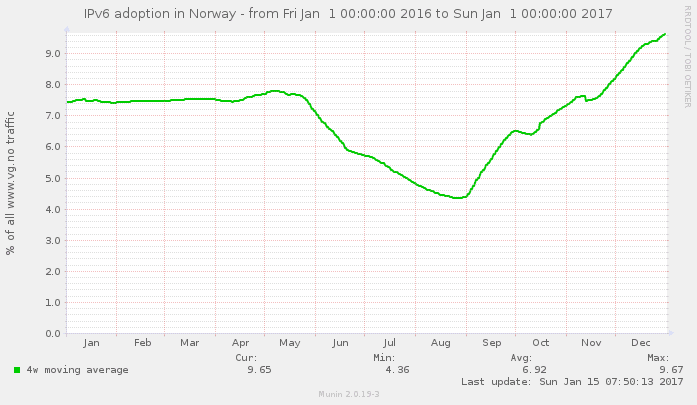
However, it is also evident from the graph that this increase was in no way a slow and steady increase, as one might expect. It started out rather boring, with practically no change at all in the first four and a half months. That changed dramatically in the middle of May, when a very negative period started. By the end of August, almost half of the IPv6-capable users we had at the beginning of the year had vanished. This was a rather glum summer for us Norwegian IPv6 enthusiasts, that much is certain.
Fortunately, the tide turned again. The last four months of the year was marked with a rapid increase in IPv6 capability that more than made up for all the lost ground in the months before. We didn’t quite make past to the 10% milestone before New Year’s Eve, but no worries, that happened less than two weeks later. The trend is looking very positive at the moment, and we’re hopeful that this will continue throughout 2017.
What caused 2016 to be such a bumpy ride, though? To answer that we need to look at statistic for the individual ISPs. This following graph shows a per-ISP breakdown of all the IPv6 traffic:
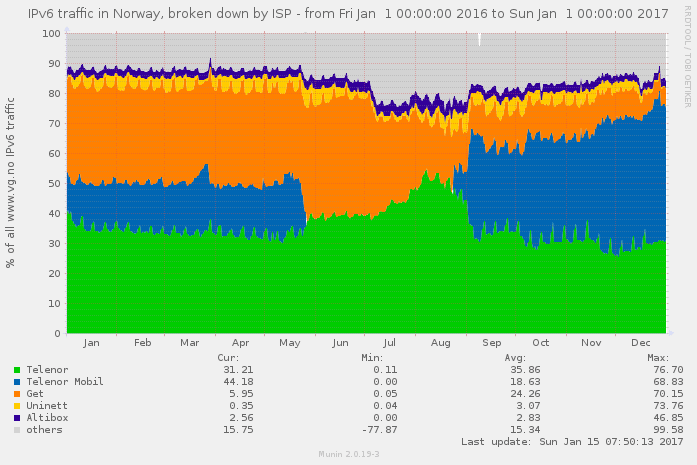
When we see graphs like this, we wonder if there has been a problem with the data collection, but that wasn’t the case. It is clear during late spring and summer, both Telenor Mobil’s and Get’s IPv6 deployments started experiencing major difficulties, which in turn caused the sharp down-tick in the overall IPv6 capability numbers. What happened with these two ISPs?
Telenor Mobil
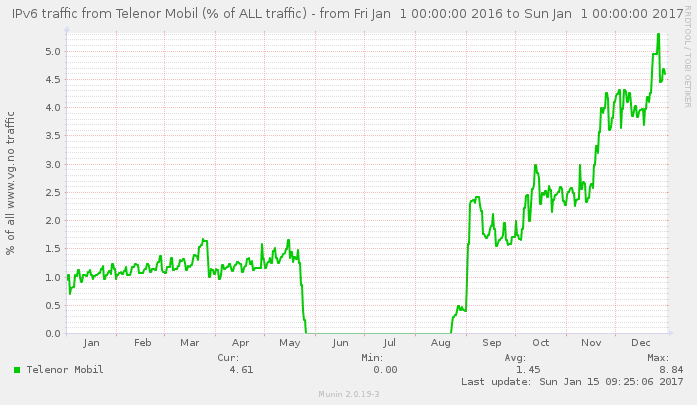
At the beginning of the year, only the Android devices in Telenor’s mobile
network were provisioned to use the dual stack telenor.smart APN. All the
Apple devices remained on a different, IPv4-only, APN.
On the 22nd of May, the Apple devices received a carrier settings update that
moved them to the telenor.smart APN. (We learned later that the primary
purpose of this update was to activate
VoLTE functionality.) There were
multiple confirmations that this caused the Apple devices to become IPv6
capable. Great news, right?
Not for long, as Telenor must have encountered an unforeseen and critical
problem in their roll-out. Just a few hours later, all IPv6 capability was
removed from the telenor.smart APN, which also impacted all the Android users
who had at that point enjoyed having IPv6 capability for several years.
We do not know for certain why they simply didn’t roll back whatever broken
change they had made, but we suspect it might be because it would be too slow
or cumbersome (requiring Apple approval and/or individual subscribers to accept
updated carrier settings, perhaps). In any case, the Apple devices have
remained on the telenor.smart APN since then.
It took three months before the problem was fixed and IPv6 capability started
gradually returning to telenor.smart. All the Android and Apple devices were
already configured to request IPv6, so recovery was quick.
As the below graph shows, at the end of the 2016, approx. 60% of the Telenor’s mobile subscriber were provisioned with and preferred to use IPv6 over IPv4. Indeed, IPv6 has replaced IPv4 as the dominant protocol - an impressive feat! Well done Telenor; we forgive you for the IPv6-less summer months you made us endure.
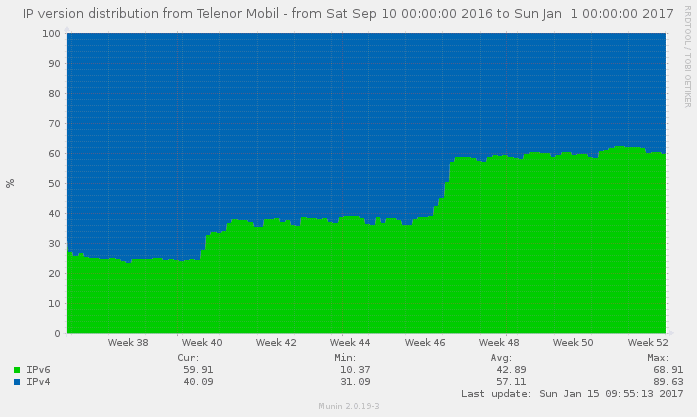
(This graph only shows the last four months of the year, as that’s when we started collecting the data necessary to compare IPv4 and IPv6 traffic levels from individual ISPs.)
Get
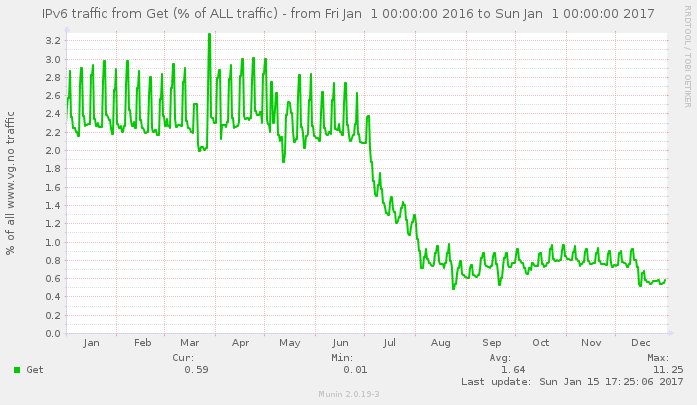
Get’s deployment of IPv6 in their DOCSIS network reached a plateau years ago. The only thing that’s been moving the needle forward is CPE churn - a slow process. We was therefore very surprised and disappointed to see their deployment take a nose dive in July.
We’ve been told the problem is some kind of bug or incompatibility between their most popular CPE/PVR device, the Get Box II, and their wireless repeater.
To deal with this problem they’ve disabled IPv6 in the Get Box II’s configuration (regardless of there being a wireless repeater present or not). Their subscribers may re-enable IPv6 if they want to, but that’s obviously not something most people will do. All in all, the amount of IPv6 traffic we saw coming from Get at the end of 2016 was just about one-fourth of what it was at the beginning of the year.
Summary and outlook for 2017
Even though they hit a rough patch, Telenor prevailed with an impressive deployment of IPv6 in their mobile network. Their overall growth compensated for Get’s downturn and then some, resulting in a net growth of about 2.5 percentage points. Telenor is the undisputed IPv6 king in Norway right now. 75%-80% of all IPv6-capable Norwegian users appear to be Telenor customers.
It is likely that Telenor’s mobile deployment have now reached a plateau, where we will no longer see sharp upticks in deployment there. Further increases is likely dependent on their subscribers replacing their old devices with new IPv6-capable ones.
There is great potential for further growth in 2017. Telenor’s fixed broadband products (DOCSIS, fibre and xDSL) have some IPv6 deployed - just shy of 20% at the end of the year. There obviously is much more to go on here, and we hear that’s their next area of focus now that their mobile deployment is essentially complete. Also, Get can obviously fix their wireless repeater and turn IPv6 back on again for all of their customer with a Get Box II, which would cause a significant bump in the graphs.
We have unfortunately no reason to be optimistic about any of the other major ISPs here, so we’ll not say anything about any of those - we’d rather be pleasantly surprised than disappointed (again).
Measurement methodology
The data used for this measurement is graciously provided to us by our friendly customer VG. VG is the second-largest newspaper in Norway, and their online edition is Norway’s largest web site. Each page view is classified as being requested by an IPv4 or an IPv6 client, and from which of the major Norwegian ISPs. This data is fed to us in real-time, and which we use to generate continuously updated graphs. Feel free to check these out if you wonder what the situation is right now. If you represent an ISP which plan on deploying IPv6 soon, please get in touch so we can add another graph that shows the data for your network too.
Update
- 2025-09-03: Format

